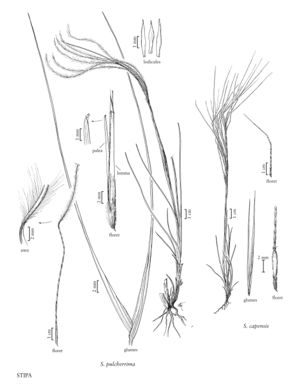Stipa capensis
Plants annual, tufted. Culms 10-100 cm, erect or geniculate, glabrous, sometimes branching from the lowermost nodes. Sheaths glabrous or pilose; collars with tufts of hair at the sides; ligules 0.4-0.7 mm, membranous, ciliate; blades to 3 mm wide, flat or convolute, abaxial surfaces glabrous, sparsely pubescent, or pilose, adaxial surfaces scabrous or hairy, hairs about 0.8 mm. Panicles 3-15 cm, contracted, often partially enclosed in the upper sheath; branches scabrous; pedicels shorter than the spikelets. Glumes 12-20 mm, narrowly lanceolate to linear, 3-veined, tapering to the hairlike apices; lower glumes equal to or exceeding the upper glumes; florets 4-7 mm, terete; calluses 1.7-2.3 mm, sharp; lemmas indurate, with overlapping margins, dorsally constricted below the apices; awns 50-100 mm, twice-geniculate, first 2 segments twisted and pilose, hairs about 1 mm, terminal segment straight, glabrous; paleas 1.2-1.5 mm, 2-veined, glabrous; lodicules 2; anthers 3, 2-2.5 mm. 2n = 36.
Discussion
Stipa capensis is known from two locations in Riverside County, California: one in Palm Springs, and the other near the mouth of Chino Canyon. A.C. Sanders (University of California, Riverside) described the latter population as a "common annual on roadside and spreading into desert vegetation" (UTC 230476).
Selected References
None.
